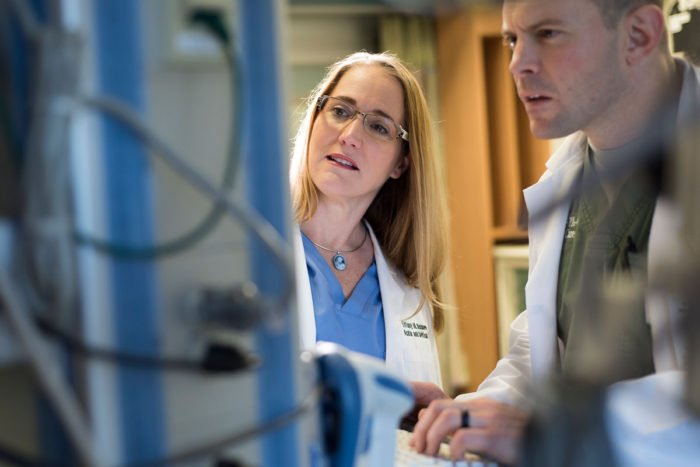Study urges aggressive identification of, treatment for sepsis
Each hour treatment is delayed increases risk of death
 Robert Boston
Robert BostonTiffany Osborn, MD, (left) a professor of surgery and of emergency medicine at Washington University School of Medicine in St. Louis, reviews data with Shawn Reynolds, a physician's assistant in anesthesiology. Osborn is a noted expert on sepsis, the leading cause of death in hospitals. She contributed to a major study advocating quick identification and treatment for sepsis.
As a resident in emergency medicine nearly two decades ago, Tiffany M. Osborn, MD, became determined to prevent people from dying of sepsis, an unruly, fast-acting, potentially fatal condition.
“I’d see patients overcome with fever, fatigue, a fast heart rate and mental confusion, and they quickly deteriorated; many died,” said Osborn, a professor of surgery and of emergency medicine at Washington University School of Medicine in St. Louis. “Little was known about sepsis then. I made it a priority to learn more.”
Osborn, who specializes in critical care and is a leading expert in sepsis, co-authored a study published May 21 in The New England Journal of Medicine that stresses the need for an aggressive response to the condition. The research was presented May 21 at the American Thoracic Society’s International Conference in Washington.
Sepsis, an extreme response to an infection, causes the body to harm itself and often results in serious illness, organ and tissue damage and even death. Each year, more than 1.6 million U.S. residents are diagnosed with sepsis, and 258,000 die from it, according to the Sepsis Alliance, an advocacy group.
“Many people have never heard about sepsis, but it is a life-threatening medical emergency,” said Osborn, who has published several studies on the condition and has worked in the U.S. and abroad to establish protocols for treatment, educational campaigns and policy initiatives. She’s worked with organizations such as the American College of Emergency Physicians and the Centers for Disease Control and Prevention, among others.
Sepsis symptoms may be stealth and varied. They include fever, shivering, high heart rate, intestinal distress, extreme pain and cognitive confusion or disorientation. “There is no definitive symptom,” Osborn said. “And each person responds to sepsis differently. Antibiotics may help one person while another person, when given the same treatment, may end up on a ventilator. It is not uncommon for a person to be languishing at home, unaware of sepsis until it’s too late.”
What were the main findings in the NEJM study?
Simply stated, our research showed that every second counts when it comes to treating sepsis. It is the leading cause of death in hospitals. The study also confirmed the importance of hospitals following a protocol to rapidly identify and treat sepsis. For each hour sepsis treatment is delayed, the study found a patient’s risk of death increases by 4 percent.
How did you and other researchers reach this conclusion?
We analyzed nearly 50,000 sepsis patients from 149 hospitals in New York state between April 2014 and June 2016. The opportunity to review such records was a first for us. We were able to do so because in 2013, New York became the first state to mandate hospital protocols for sepsis identification and treatment.
What kind of protocols?
New York required what is known as the three-hour bundle. This means that within three hours of a sepsis diagnosis, health-care workers must give patients a broad-spectrum antibiotic treatment, take a blood culture to test for infection and measure blood lactate, which indicates whether there is physiological stress. Hospitals are required to submit data on compliance and outcomes to the state health department.
The protocols emerged after Rory Staunton, a 12-year-old from New York, died of undiagnosed sepsis in 2012. Rory was a healthy boy who cut his arm during a basketball game. This happens to many kids, usually without incident. However, Rory’s cut became infected, and it developed into sepsis. He died less than a week after his sports injury. The Staunton family has worked tirelessly to educate health-care workers and the general population about sepsis. The family’s efforts helped lead to the passage in New York of what is known as “Rory’s Regulations,” the mandate requiring hospitals to establish protocols for sepsis
Since Rory’s Regulations, other medical centers and networks, including BJC Healthcare, have adopted similar protocols for sepsis. In 2015, the Centers for Medicare and Medicaid Services, which oversees federal insurance programs, required hospitals that receive federal funding — and that is most hospitals— to document and follow sepsis protocols.
How did you get involved in this study?
The study was led by researchers at the University of Pittsburgh School of Medicine but also involved scientists from institutions in Michigan, Ohio and New York. I represented Washington University.
I was requested to help with the analysis because of my extended background in sepsis, as well as my experience in both emergency and critical care medicine.
What is main takeaway from the NEJM study?
For health-care workers, it’s to identify and treat sepsis as quickly as possible. There is no time to waste.
For the general population, it’s to recognize sepsis symptoms and immediately go to an emergency department. It’s better to be safe.






